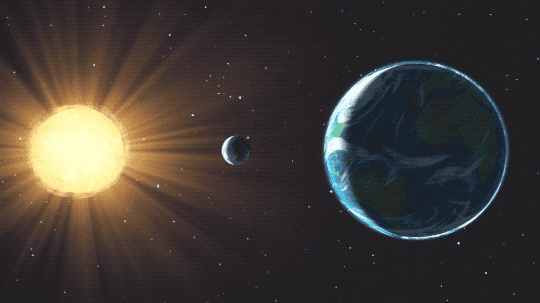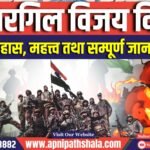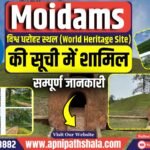Eclipse – Solar Eclipse and Lunar Eclipse
What’s in this Article?
- Table of Contents
- Why in the News?
- What is Solar Eclipse?
- Three main types of Solar Eclipses
- The scientific impact of Solar Eclipses (Surya Grahan)
- Solar Eclipses (Surya Grahan) Across Cultures
- Lunar Eclipse (Chandra Grahan)
- Conclusion
- FAQs
- MCQs
Why in the News?
- An astronomical spectacle is all set to captivate skywatchers as a total solar eclipse is set to grace the skies across North America, turning day into night, on April 8.
- Total eclipses are dramatic and turn the sky dark, but they are only visible from a few locations.
- This is why the opportunity to experience an eclipse is often called a once-in-a-lifetime opportunity.
What is Solar Eclipse?
- A solar eclipse, known as “Surya Grahan” in some cultures, is a remarkable astronomical event marked by the Moon positioning itself between Earth and the Sun.
- During this event, the Moon’s interposition obscures the Sun, momentarily casting a shadow over a portion of the Earth, either completely or partially.
- Solar Eclipses (Surya Grahan) Occur: The occurrence of a solar eclipse hinges on a precise alignment of the Sun, Moon, and Earth.
- It is when the Moon passes directly between Earth and the Sun that the Sun’s radiant light is momentarily concealed from view.
- Moon’s Orbital Influence: Solar eclipses take place approximately every six months during the new moon phase.
- This timing coincides with when the Moon’s orbital plane is in close proximity to the plane of Earth’s orbit.
- This synchronized celestial dance creates the conditions necessary for this captivating spectacle to unfold.
- Shadow Formation During Solar Eclipses: During a solar eclipse (Surya Grahan), two distinctive shadows are cast upon the Earth by the Moon, each offering a unique viewing experience:
- The Umbra: It represents the innermost and darkest region of the Moon’s shadow.
- Those situated within the umbra are in for a spectacular treat – a total eclipse.
- As this shadow extends towards Earth, it gradually shrinks in size, creating a path of complete darkness.
- The Penumbra: The Penumbra, in contrast, is the outer part of the Moon’s shadow.
- It encompasses a larger area as it stretches towards Earth.
- Within the penumbra, observers are treated to a partial eclipse, where the Sun is only partially obscured.
- This broader region provides a unique celestial display, distinct from the totality of the umbra.
There are three main types of solar eclipses:
1. Total solar eclipse:
- A total solar eclipse is visible from a small area on Earth.
- The people who see the total eclipse are in the center of the Moon’s shadow when it hits Earth.
- The sky becomes very dark, as if it were night.
- For a total eclipse to occur, the Sun, Moon and Earth must be in a direct line.
- No sunlight penetrates the umbra, the inner part of the shadow.
- To observers on the Earth within the umbra, the disk of the Sun will appear completely covered by that of the Moon.
- Such a solar eclipse is said to be total. Because the umbra is narrow at its intersection with the Earth, a total eclipse can be observed only within a very narrow area–the zone of totality.
- Furthermore, because of the relative motion of the bodies, the conical shadow moves rapidly over the terrestrial surface; the totality of the solar eclipse thus lasts only a short time (less than eight minutes at any one place on the Earth).
2. Partial Solar Eclipse:
- A partial solar eclipse takes place when the Sun, Moon, and Earth are not perfectly aligned.
- In this scenario, only a portion of the Sun’s surface appears to be covered by the Moon, resulting in a crescent shape.
- People outside the Moon’s inner shadow area during a total or annular eclipse observe a partial solar eclipse.
3. Annular (an-ye–ler) solar eclipse:
- An annular eclipse happens when the Moon is farthest from Earth.
- Because the Moon is farther away, it seems smaller.
- It does not block the entire view of the Sun.
- The Moon in front of the Sun looks like a dark disk on top of a larger Sun-colored disk.
- This creates what looks like a ring around the Moon.
- An annular eclipse happens when the moon is farthest from Earth. Because the moon is farther away from Earth, it seems smaller. It does not block the entire view of the sun. The moon in front of the sun looks like a dark disk on top of a larger sun-coloured disk. This creates what looks like a ring around the moon.
- During a solar eclipse, the moon casts two shadows on Earth. The first shadow is called the Umbra. This shadow gets smaller as it reaches Earth. It is the dark centre of the moon’s shadow.
- The second shadow is called the Penumbra. The penumbra gets larger as it reaches Earth. People standing in the penumbra will see a partial eclipse. People standing in the umbra will see a total eclipse.
Hybrid Solar Eclipse:
- The Earth’s curved surface can lead to a shifting eclipse type as the Moon’s shadow moves across the planet. This unique situation is referred to as a hybrid solar eclipse.
- It may transition between annular and total eclipses as it progresses across different regions.
- These various solar eclipse types create captivating astronomical events that capture the attention of people around the world.
Total Solar Eclipse Date and Timings:
- The total solar eclipse of 2024 occurred on April The total darkening of the sky, also known as totality, was visible across a 185-kilometre stretch between Mexico, the US, and Canada. As many as 18 different US States also get to see it. However, it was nor visible to skywatchers in India.
- According to the Indian Standard Time (IST), the total solar eclipse was begin at 9:12 pm on April 8, totality started at 10:08 pm, and end on April 9, 2024, at 2:22
- The Pacific coast of Mexico experienced totality first, around 11:07 am PDT, and the occurrence leaved Maine at around 1:30 pm PDT.
Total Solar Eclipse Duration
- The whole event will take about two and a half hours, but totality will only last about four minutes. As per NASA, the peak spectacle is expected to last for up to 4 minutes and 27 seconds in the path of total darkness.
- “The duration of totality will be up to 4 minutes and 27 seconds, almost double that of The Great American Eclipse of August 21, 2017,” according to Great American Eclipse. Most places along the centerline (path of totality) will see a totality duration between 5 and 4 minutes.
The Scientific Impact of Solar Eclipses (Surya Grahan)
- Study Temperature Variation: Temperature drop during an eclipse can lead to cooling of the upper atmosphere.
- This event is likely to affect the temperature structure of the ionosphere.
- Radio Frequency Variation: Electron density in the ionosphere will decrease due to cooling in the ionosphere.
- This will have an impact on propagation of radio waves, particularly of high frequency.
- Satellite Communication Challenges: Anomalies in the ionosphere will impact satellite-based navigation signals and also communication.
- Studying Environmental Changes: Studies have shown that solar eclipses (Surya Grahan) can alter Earth’s temperature, relative humidity, wind speed and also ozone density.
- Helps in Solar Studies: Eclipses of the Sun allow scientists to study the Sun’s atmosphere called the corona, which otherwise is not possible due to the bright light of the Sun.
Solar Eclipses (Surya Grahan) Across Cultures
- Indian Culture:
- Evidence: The oldest reference of Eclipse in India is in the Rig Veda that describes the effect of eclipse.
- Means of Attaining Salvation: Skanda Purana has a legend where sages witness a forest-dwelling woman transform into a beauty after bathing in a holy lake during a solar eclipse (Surya Grahan), implying that it is a way of attaining salvation.
- Ancestral Duties: According to Padma Purana, a man who offers water to his ancestors during a solar eclipse (Surya Grahan) achieves heaven.
- However, he becomes a Chandala in case of failure to do so.
Influence on Art, Literature, and Religion
- Art: Eclipse has been portrayed in paintings as a monster, dragon, and even a celestial dog, swallowing the sun in ancient Maya and Chinese culture.
- They were used in the backdrop of European Renaissance crucifixion scenes to give a sorrowful effect.
- Literature: In Homer’s Odyssey, the protagonist returns to his kingdom, accompanied by a seer’s vision of an eclipse.
- Egyptian Culture: In ancient Egypt, the King who saw himself as a representative of the Sun went around the city to reassure people.
- Chinese Culture: Chinese considered eclipses to be omens that predicted the future of the Emperor, and hence was important to predict eclipses.
Lunar Eclipse
- Also known as the eclipse of the moon or “Chandra Grahan”, it occurs when the earth comes in between the sun and the moon.
- As a result, the earth blocks the light of the sun from reaching the moon’s surface and casts its shadow on the moon. It occurs on a full moon day.
- We can observe up to 3 lunar eclipses per year.
- A lunar eclipse occurs when the Moon moves into the Earth’s shadow.
- For a lunar eclipse to happen, the Earth must be positioned directly between the Sun and the Moon, and this celestial event can only take place during a full Moon.
Here’s how a lunar eclipse unfolds:
- Penumbral Phase:
- The Moon first moves into the Earth’s penumbra, which is the outer part of the Earth’s shadow. During this phase, not all of the Sun’s light is completely blocked out. As a result, a portion of the Moon’s surface appears dimmer than during a typical full Moon.
- Umbral Phase
- Subsequently, the Moon progresses into the Earth’s umbra, which is the inner and darker part of the Earth’s shadow. In this phase, direct sunlight from the Sun is entirely blocked by the Earth, causing the only light illuminating the Moon’s surface to be light that has been refracted, or bent, by passing through the Earth’s atmosphere.
- Total Lunar Eclipse
- It occurs when the Earth positions itself between the Sun and the Moon, causing its shadow to be cast upon the lunar surface. During this event, the entire lunar disk enters the Earth’s umbra, leading to a reddish appearance of the Moon, often referred to as a “Blood Moon.”
- The Moon appears red during a Total Lunar Eclipse due to a phenomenon known as Rayleigh scattering.
- Rayleigh scattering is the scattering of light by particles in a medium without any change in its wavelength. This is the same reason why our sky appears blue. The Moon takes on this reddish hue because the only sunlight reaching it has passed through the Earth’s atmosphere. During this passage, the sunlight scatters as it interacts with dust or clouds in our atmosphere, producing the red coloration.
- Total lunar eclipses occur approximately once every year and a half, according to NASA (National Aeronautics and Space Administration).
- Partial Lunar Eclipse
- It happens when there is an imperfect alignment of the Sun, Earth, and Moon. In this case, the Moon only partially enters the Earth’s umbra, and the shadow doesn’t completely cover the entire lunar surface. The shadow grows and then retreats without fully obscuring the Moon.
- Penumbral Eclipse
- It involves the Moon passing through the Earth’s penumbra, which is the faint, outer part of the Earth’s shadow. This results in only a subtle dimming of the Moon, often challenging to notice compared to the more dramatic total or partial lunar eclipse.
Conclusion
- In conclusion, solar eclipse is one of the crucial celestial phenomena.
- In this, the moon, sun and earth come in a straight line during their revolution.
- The moon comes in the front of the sun while revolving around the earth. Due to this, the moon blocks the sunlight and causes its shadow to fall on earth.
- There are three types of solar eclipses which are annular, partial and total.
- Hence, during the eclipse, the temperature goes down, magnitude increases and ozone levels decrease. Also, the temperature and humidity levels decrease during the solar eclipse.
- In conclusion, a lunar eclipse arises when the sun, moon, and earth come into a straight line. The earth comes in the middle of the moon and the sun in this process.
- As a result, the shadow of the earth falls upon the moon. Due to this reason, the moon appears to be darker. There are three different types of lunar eclipses.
- They are penumbral eclipse, partial eclipse, and total lunar eclipse. Therefore, total and partial eclipses are common and easy to observe compared to the penumbral lunar eclipse.
Disclaimer: The article may contain information pertaining to prior academic years; for further information, visit the exam’s “official or concerned website“.
Frequently Asked Questions (FAQ’s)
Q. What is an eclipse?
- An eclipse is a celestial event that happens when a spacecraft or an astronomical body is temporarily optically blocked by passing into another body’s shadow or by having another object pass between it and the observer.
Why don’t solar eclipses happen at every New Moon?
- The reason is that the Moon’s orbit tilts 5° to Earth’s orbit around the Sun.
- Astronomers call the two intersections of these paths nodes.
- Eclipses only occur when the Sun lies at one node and the Moon is at its New (for solar eclipses) or Full (for lunar eclipses) phase.
- During most (lunar) months, the Sun lies either above or below one of the nodes, and no eclipse happens.
Q. What are the two types of natural eclipses that can be observed from the Earth?
- Solar eclipses and lunar eclipses are the two types of natural eclipses that can be observed from the Earth.
Q. What is a solar eclipse?
- A solar eclipse happens when the moon comes in between the sun and the Earth. As a result, the moon blocks the light of the sun from reaching the Earth’s surface and casts a shadow on it. This occurs during the new moon phase. We can observe up to 5 solar eclipses per year.
Q. What are the three types of solar eclipses?
- The three types of solar eclipse are partial, annular and total solar eclipse.
Q. What is a lunar eclipse?
- A lunar eclipse happens when the Earth comes in between the sun and the moon. As a result, the Earth blocks the sun’s light from reaching the moon’s surface and casts its shadow on the moon. It occurs on a full moon day. We can observe up to 3 lunar eclipses per year.
Q. What causes a solar eclipse?
- A solar eclipse occurs when the Moon passes between the Earth and the Sun, blocking all or part of the Sun’s light. This happens only during a new moon when the three celestial bodies are aligned in a straight line.
Q. How often do solar eclipses occur?
- Solar eclipses are relatively rare events, happening around two to five times per year somewhere on Earth. However, any given location may only experience a solar eclipse once every few years.
Q. Why doesn’t a solar eclipse happen every month during the new moon phase?
- While a new moon occurs approximately once every month, a solar eclipse doesn’t happen every time because the Moon’s orbit is tilted slightly compared to the Earth’s orbit around the Sun. Thus, the alignment required for a solar eclipse doesn’t occur every new moon.
Q. What is a lunar eclipse and how does it occur?
- A lunar eclipse happens when the Earth passes between the Sun and the Moon, casting its shadow on the Moon. This occurs during a full moon when the Earth, Sun, and Moon are aligned in a straight line.
Q. How often do lunar eclipses occur?
- Lunar eclipses are more common than solar eclipses. On average, there are about two to four lunar eclipses every year. However, not all of them are total lunar eclipses; some may be partial or penumbral eclipses, where the Moon only partially enters Earth’s shadow.
MCQ’s
Q. In the northern hemisphere, the longest day of the year normally occurs in the:
- First half of the month of June
- Second half of the month of June
- First half of the month of July
- Second half of the month of July
Ans: b (Second half of the month of June)
Q. On 21st June, the Sun
- does not set below the horizon at the Arctic Circle
- does not set below the horizon at Antarctic Circle
- shines vertically overhead at noon on the Equator
- shines vertically overhead at the Tropic of Capricorn
Ans: a (does not set below the horizon at the Arctic Circle)
























